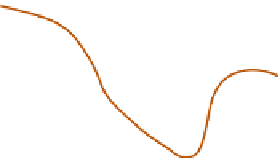Geoscience Reference
In-Depth Information
50
20
(A)
100
15
200
J
W
J
W
10
-60°
300
-50°
-50°
-30°
400
500
5
-
30°
0
1000
10°N
20°N
30°N
40°N
50°N
60°N
70°N
80°N
90°N
50
20
(B)
100
80
15
J
E
J
W
200
10
J
W
300
-10°
400
500
-1
0°
5
10°
0
°
20°
0
1000
10°N
20°N
30°N
40°N
50°N
60°N
70°N
80°N
90°N
Isotachs (km hr
-1
)
East winds
Tropopause
Isotherms (°C)
Figure 11.17
Distribution of wind velocity (km/hr) and temperature (°C) along the 90°E meridian for January and
July, showing the westerly jet streams (J
W
) and the tropopause. Note the variable intervals in the height and
latitudinal scales.
Source: After Pogosyan and Ugarova (1959). From Meteorologiya Gidrologiya.
becoming northeasterly over Burma and
Bangladesh and easterly over peninsular India.
Equally important is the steering of winter
depressions over northern India by the upper jet.
The lows, which are not usually frontal, appear
to penetrate across the Middle East from the
Mediterranean and are important sources of
rainfall for northern India and Pakistan (e.g., Kalat:
Figure 11.20
), especially as it falls when evapora-
tion is at a minimum. The equatorial trough of
convergence and precipitation lies between the
equator and about latitude 15°S (see
Figure 11.16
).
Some of these westerly depressions continue
eastward, redeveloping in the zone of jet stream








































































































































































